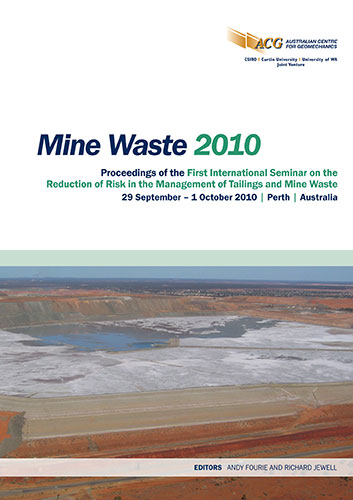Environmental and economical success through advanced tailing separation process

|
Authors: Raberger, R; Ziaja, D; Godwin, P Paper is not available for download Contact Us |
DOI https://doi.org/10.36487/ACG_rep/1008_21_Raberger
Cite As:
Raberger, R, Ziaja, D & Godwin, P 2010, 'Environmental and economical success through advanced tailing separation process', in R Jewell & AB Fourie (eds), Mine Waste 2010: Proceedings of the First International Seminar on the Reduction of Risk in the Management of Tailings and Mine Waste, Australian Centre for Geomechanics, Perth, pp. 243-250, https://doi.org/10.36487/ACG_rep/1008_21_Raberger
Abstract:
Worldwide high-grade ores at easily accessible sites become more difficult to find and mine since the known high grade sites are already exploited or located at remote areas. Low grade ore sites receive increasing attention, which challenges beneficiation technologies to become economical. Existing mining waste and more often newly generated mining waste — in particular tailings — become an interesting source to produce additional concentrates, without actual mining costs at over-above profit margins. Furthermore, environmental concerns demand actions towards the huge amounts of tailings, which are already stored in dams. They may need to be treated to clean-up existing environmental damage. Moreover, if the supernatant water is used as process water, the waste volume is minimised and the hazardous impact is reduced. The separation of the tailings into product and waste as well as into a liquid and solid fraction represents an essential process to generate additional profits. Examples are the filtration of red mud and treatment of copper tailings. The plant concept of OAO Severstal Slurry Pond Treatment, Russia is presented, where coal tailings are recycled. Approximately 50% of the solid content of the tailings is converted to a valuable product meeting all required specifications of ash content and residual moisture. The process applied in this plant consists of classification, flotation and liquid solid separation. As an alternative, hyperbaric filtration can be used to replace a dryer together with a vacuum disc filter. The process solution presented here is tailor-made and depends upon the local situation in terms of coal quality target and tailing specifications.
References:
Haehling, G. (2005) Hyperbaric Filtration: Operating Experience with Andritz Hyperbaric Filters (HBF) for Dewatering
Fines in Coal Prep Plants, Coal Prep, Lexington 2005.
Environmental and economical success through advanced tailing separation process R. Raberger et al.
250 Mine Waste 2010, Perth, Australia
Markworth, L., Ören, E. and Gerards, M. (2010) Cost Efficient Application for Fine Coal Beneficiation, Coal Prep,
Lexington 2010.
Raberger, R. and Krammer, G. (2009) How to Meet the Challenge of Tailings Filtration, in Proceedings First
International Seminar on Environmental Issues in the Mining Industry (Enviromine 2009), J. Wiertz and
C. Moran (eds), 30 September – 2 October 2009, Santiago, Chile, Gecamin, Santiago, Ch. 4, Paper 37.
Schnabel, G. and Raaf, T. (2006) A fine Art – A new dewatering system for coal fines, which challenges established
processes by using screen bowl centrifuges and hyperbaric filters combinations, World Coal, July, pp. 43–46.
© Copyright 2026, Australian Centre for Geomechanics (ACG), The University of Western Australia. All rights reserved.
View copyright/legal information
Please direct any queries or error reports to repository-acg@uwa.edu.au
View copyright/legal information
Please direct any queries or error reports to repository-acg@uwa.edu.au